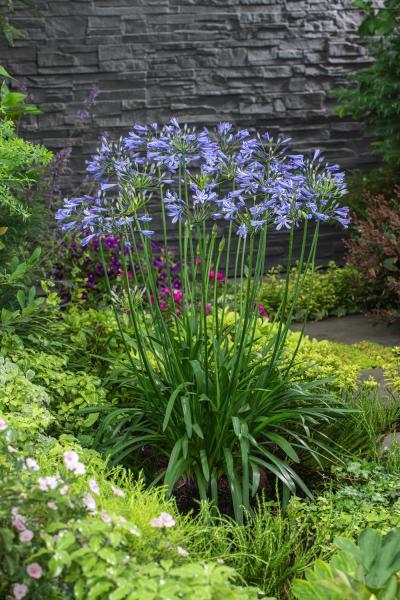Mastering the Art of Agapanthus Treatment: Necessary Steps for Healthy Development and Lively Blooms
In the realm of gardening, the farming of agapanthus stands as a fulfilling venture for those who seek to support these sophisticated flowering plants. From choosing the ideal range to grasping pruning techniques, the trip in the direction of cultivating thriving agapanthus plants is complex and holds the vital to opening the full potential of these organic gems.

Selecting the Right Agapanthus Variety

When picking the best Agapanthus range for your yard, take into consideration elements such as climate suitability, blossom shade, and development habit. Agapanthus, frequently called Lily of the Nile or African lily, can be found in a variety of shades ranging from shades of purple and blue to white. Select a flower color that matches your existing garden palette to develop an unified landscape. Additionally, consider the environment in your area to make certain the Agapanthus selection you choose can thrive in your particular conditions. Some selections are extra tolerant of cool temperatures, while others favor warmer environments. Understanding the development routine of different Agapanthus varieties is vital for appropriate positioning within your garden. Some varieties have a clumping growth habit, ideal for boundaries or containers, while others have a more spreading nature, appropriate for ground cover or mass plantings. By carefully examining these elements, you can pick the excellent Agapanthus selection to boost the appeal of your yard.
Suitable Planting Problems
Thinking about the optimum ecological demands is essential for successful Agapanthus farming. Agapanthus thrives in well-draining dirt with a somewhat acidic to neutral pH degree. When growing, pick a place that obtains full sunlight to partial shade. In hotter climates, supplying some afternoon shade can stop scorching of the leaves. Agapanthus plants are sensitive to chilly temperatures and ought to be safeguarded from frost during wintertime months.
To make sure healthy and balanced growth and vivid flowers, plant Agapanthus light bulbs at a depth of concerning 2-4 inches and area them 8-12 inches apart. Adding raw material, such as compost, to the dirt can improve drainage and fertility, advertising robust root development. Mulching around the base of the plants assists maintain moisture and suppresses weed growth. Routine watering is vital, particularly during the expanding period, to keep the soil regularly moist but not soaked.
Watering and Feeding Tips
Keeping appropriate wetness degrees and supplying necessary nutrients are essential components in the care regimen for Agapanthus plants. When it comes to watering Agapanthus, it is vital to strike an equilibrium. These plants choose regularly wet soil however are vulnerable to root rot if overwatered. Throughout the expanding period, water deeply when a week, ensuring the dirt is well-draining to avoid waterlogging. In hotter environments or throughout durations of drought, even more regular watering might be required to keep the dirt evenly wet. However, reduce watering in the winter months to avoid waterlogged conditions.
Feeding Agapanthus is necessary for promoting healthy and balanced growth and respected blooms. Apply a well you could look here balanced fertilizer, visit homepage such as a 10-10-10 formula, in the early spring as brand-new development arises. By following these watering and fertilizing suggestions, you can ensure your Agapanthus plants thrive and generate vivid, long-lasting blooms.
Trimming Methods for Agapanthus
Trimming Agapanthus plants at the proper times and with correct methods is critical for maintaining their wellness and promoting optimal growth and flowering. The perfect time to trim Agapanthus remains in late winter months or early springtime before new growth emerges. Begin by eliminating any yellowing or dead fallen leaves near the base of the plant. Cut them as short as feasible without damaging the arising shoots.
Deadheading invested blossoms can also redirect the plant's energy right into generating even more flowers rather than setting seeds. If you desire to collect seeds for proliferation, leave some flowers to fully grown and completely dry on the plant.
Remember to use tidy, sharp tools to make accurate cuts and lower the threat of introducing illness. Agapanthus. Normal pruning will certainly help keep your Agapanthus looking healthy and balanced and neat while guaranteeing a plentiful display screen of stunning blossoms
Dealing With Usual Insects and Conditions
After making certain correct pruning strategies for Agapanthus, it is necessary to attend to common bugs and diseases that can impact the health and wellness and vitality of these plants. Agapanthus plants are usually hardy yet can still succumb to specific issues. One common bug that affects Agapanthus is the Agapanthus gall midge. This little, orange fly lays its eggs in the vegetation, bring about distorted development and flower buds that fail to open up. To fight this parasite, prune and damage any kind of affected plant parts and take into consideration using insecticidal soap.
Furthermore, Agapanthus plants can suffer from root rot if they are planted in poorly draining pipes dirt. By being attentive and taking timely activity versus illness and pests, you can help your Agapanthus plants flourish and generate vivid blooms. Agapanthus.

Final Thought
To conclude, mastering the art of agapanthus treatment includes selecting the ideal variety, giving suitable planting problems, correct watering and fertilizing, proper trimming techniques, and resolving typical insects and diseases. By following these essential actions, you can make sure healthy development and lively blossoms for your agapanthus plants. Bear in mind to routinely keep track of and preserve your plants to promote their overall wellness and durability.
To make certain healthy and balanced development and vivid flowers, plant Agapanthus bulbs at a depth of regarding 2-4 inches and space them 8-12 inches apart. By adhering to these watering and fertilizing suggestions, you can guarantee your Agapanthus plants prosper and produce vibrant, durable blossoms.
One common try this website insect that impacts Agapanthus is the Agapanthus gall midget. Furthermore, Agapanthus plants can endure from origin rot if they are planted in poorly draining pipes soil. By complying with these necessary steps, you can make certain healthy growth and dynamic blossoms for your agapanthus plants.